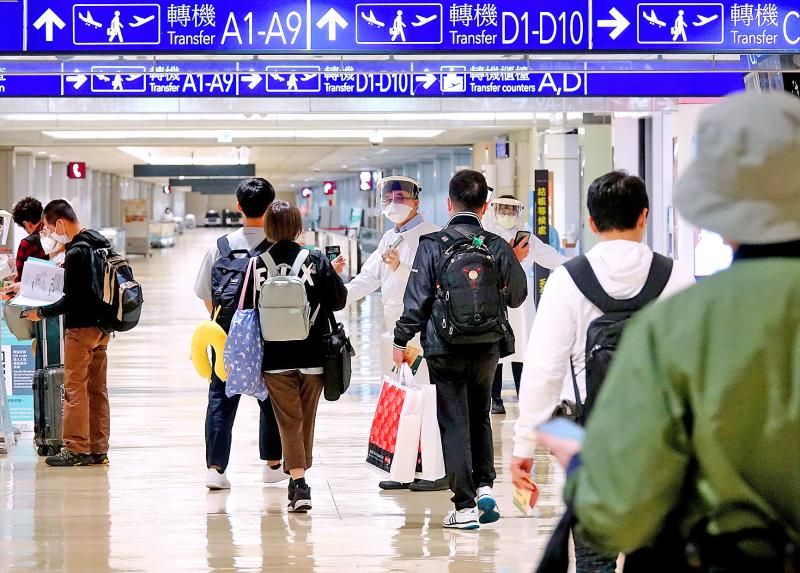Taiwan’s first cases of the new Omicron subvariants BA.4 and BA.5 of SARS-CoV-2 have been detected in five people arriving from overseas, the Central Epidemic Command Center (CECC) said yesterday.
Centers for Disease Control Deputy Director-General Philip Lo (羅一鈞), who is deputy head of the CECC’s medical response division, said genome sequencing conducted on virus samples from 57 imported cases last week showed that four people were infected with the BA.5 subvariant, one with the BA.4 subvariant and the rest with the BA.2 subvariant.
While the new subvariants account for a small proportion of total imported cases, they have not been found in local cases, he added.

Photo: Chu Pei-hsiung, Taipei Times
The four cases of the BA.5 subvariant were found in people who arrived from the US, Turkey and Poland, while the BA.4 subvariant was found in a traveler who arrived from Chile, Lo said.
The people with BA.5 infections are asymptomatic or have mild COVID-19 symptoms, with one reporting a sore throat and another an abnormal sense of taste, he said.
Health authorities in South Africa first detected the BA.4 and BA.5 subvariants in January and February respectively, Lo said, adding that they triggered a new wave of COVID-19 infections in that country in April and May.
Studies have shown that the two subvariants are more easily transmitted than previous Omicron subvariants and have a degree of “immune escape” — the ability to evade immune protection in the body induced by previous infection or vaccination, he said.
WHO data released on Wednesday last week showed that the BA.4 and BA.5 subvariants have been reported in more than 40 countries, he said.
“Based on current studies, there is no indication that the Omicron BA.4 and BA.5 subvariants cause a higher risk of severe cases, but they are more contagious and capable of escaping immune protection,” he said, adding that the center is closely monitoring any changes in COVID-19 detected in imported cases, while increasing vaccination rates.
The risk of being reinfected with the same strain of SARS-CoV-2 is relatively low, but not impossible, Lo said, adding that if the BA.4 and BA.5 subvariants become the primary circulating viruses in the local community, the risk of reinfection could rise.
Experts agree that a person’s immune protection from a previous COVID-19 infection can last about three months, but a few people might still contract the disease again, he said.
Asked whether “herd immunity” would be effective against the BA.4 and BA.5 subvariants, Lo said that the local outbreak is mainly caused by the BA.2 subvariant, with antibodies protecting against the BA.1 and BA.2 subvariants for at least three to four months.
Over the weekend, he said the BA.1 subvariant has not been recorded locally since April 21.

The US government has signed defense cooperation agreements with Japan and the Philippines to boost the deterrence capabilities of countries in the first island chain, a report by the National Security Bureau (NSB) showed. The main countries on the first island chain include the two nations and Taiwan. The bureau is to present the report at a meeting of the legislature’s Foreign Affairs and National Defense Committee tomorrow. The US military has deployed Typhon missile systems to Japan’s Yamaguchi Prefecture and Zambales province in the Philippines during their joint military exercises. It has also installed NMESIS anti-ship systems in Japan’s Okinawa

‘WIN-WIN’: The Philippines, and central and eastern European countries are important potential drone cooperation partners, Minister of Foreign Affairs Lin Chia-lung said Minister of Foreign Affairs Lin Chia-lung (林佳龍) in an interview published yesterday confirmed that there are joint ventures between Taiwan and Poland in the drone industry. Lin made the remark in an exclusive interview with the Chinese-language Liberty Times (the Taipei Times’ sister paper). The government-backed Taiwan Excellence Drone International Business Opportunities Alliance and the Polish Chamber of Unmanned Systems on Wednesday last week signed a memorandum of understanding in Poland to develop a “non-China” supply chain for drones and work together on key technologies. Asked if Taiwan prioritized Poland among central and eastern European countries in drone collaboration, Lin

The Chien Feng IV (勁蜂, Mighty Hornet) loitering munition is on track to enter flight tests next month in connection with potential adoption by Taiwanese and US armed forces, a government source said yesterday. The kamikaze drone, which boasts a range of 1,000km, debuted at the Taipei Aerospace and Defense Technology Exhibition in September, the official said on condition of anonymity. The Chungshan Institute of Science and Technology and US-based Kratos Defense jointly developed the platform by leveraging the engine and airframe of the latter’s MQM-178 Firejet target drone, they said. The uncrewed aerial vehicle is designed to utilize an artificial intelligence computer

Renewed border fighting between Thailand and Cambodia showed no signs of abating yesterday, leaving hundreds of thousands of displaced people in both countries living in strained conditions as more flooded into temporary shelters. Reporters on the Thai side of the border heard sounds of outgoing, indirect fire yesterday. About 400,000 people have been evacuated from affected areas in Thailand and about 700 schools closed while fighting was ongoing in four border provinces, said Thai Rear Admiral Surasant Kongsiri, a spokesman for the military. Cambodia evacuated more than 127,000 villagers and closed hundreds of schools, the Thai Ministry of Defense said. Thailand’s military announced that